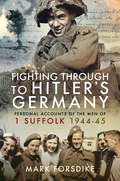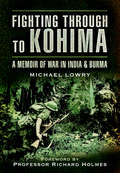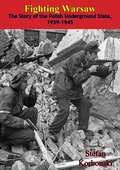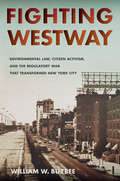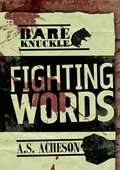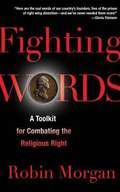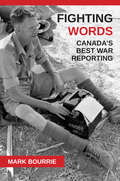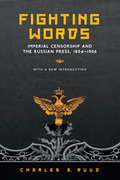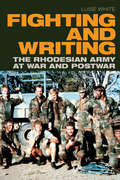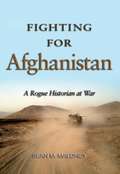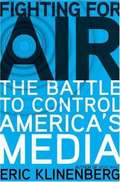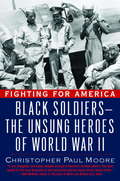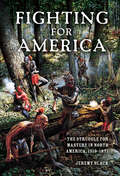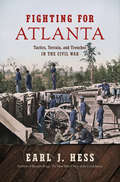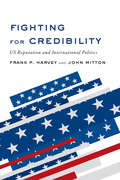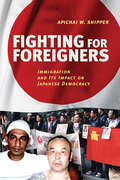- Table View
- List View
Fighting Through to Hitler's Germany: Personal Accounts of the Men of 1 Suffolk 1944–45
by Mark Forsdike&“The real story of how the Second World war was won in Europe . . . Packed with the personal stories of the men who were there.&” —Clash of Steel After landing on D-Day, 1st Battalion, The Suffolk Regiment fought through France, Holland and into Germany as part of the 3rd (British) Infantry Division. Ever cheerful, the Battalion were opposed by an increasingly ruthless enemy determined to deny the invader their homeland. As the campaign developed, 1 Suffolk acquired an enviable reputation for getting the job done with the minimum of fuss. Inevitably casualties mounted up and, of the 850 who landed on D-Day, just 178 were still serving on VE-Day; 215 had been killed and 640 wounded. The Battalion&’s success was due in large measure to fine leadership and all four commanding officers went on to enjoy distinguished careers. But without the stalwart fighting spirit and comradeship of all ranks none of the Battalion&’s achievements would have been possible. This fine book draws on the testimonies of officers and men who served in this historic campaign. Recognition of the fighting record of 1 Suffolk is long overdue and the author is to be congratulated for pulling together these inspiring first-hand accounts along with many previously unpublished photographs.A Soldier Magazine Top Read of the Year&“Brings life to the story of in this case World War II, and gives an insight into what this war was like. The author deserves praise for the way he has presented the words of these men, as it makes for a very engaging read.&” —Armorama
Fighting Through to Kohima: A Memoir of War in India and Burma
by Michael LowryA decorated British officer&’s wrenching and inspiring firsthand account of the worst battle of the Burma campaign. Lt. Col. Michael Lowry MC MBE, was awarded the Military Cross for his role in the desperate defensive action at Kohima, considered the worst of the campaign in Burma. After joining up in 1939 with the Queen&’s Royal Regiment, Lowry was posted to the North West Frontier of India, where he cut his teeth chasing gangs of Pathan bandits for two years. As the Japanese advanced into Burma, Lowry found himself fighting in the Arakan region, where his battalion was cut off by the Japanese for three weeks. Having survived that, next came the action at Kohima—where in the course of one week Lowry&’s battalion lost 173 members. Lowry was seriously wounded in the conflict but fortunately lived to tell the tale. This is a fascinating and inspiring book, one of the most action-packed memoirs of the war in Burma ever published.
Fighting Toxic Ignorance: Origins of the Right to Know about Workplace Health Hazards
by Alan DericksonFighting Toxic Ignorance explores conflict over access to information regarding health hazards encountered in the US workplace during the first three-quarters of the twentieth century. Alan Derickson considers risks posed by toxic chemicals and physical and biological agents of disease. By the 1970s, occupational disease was estimated to kill up to 100,000 Americans a year. Derickson unravels the social and political forces and the conflictual process that gave rise to a sustained social movement for a workers' right to know about often-insidious threats. He argues that the decades prior to the emergence of this movement were not a dark age of victimization brought about by enforced ignorance but a time of recurrent battles over the disclosure of needed facts. Workplace warnings—informative signs, labels, and instructions—often saved lives. Fighting Toxic Ignorance covers a broad range of dangerous substances, deals with a large share of the national workforce, and illuminates the many ways that activists endeavored to see that warnings reached workers, especially immigrants and workers of color.
Fighting Traffic: The Dawn of the Motor Age in the American City (Inside Technology)
by Peter D. NortonThe fight for the future of the city street between pedestrians, street railways, and promoters of the automobile between 1915 and 1930.Before the advent of the automobile, users of city streets were diverse and included children at play and pedestrians at large. By 1930, most streets were primarily a motor thoroughfares where children did not belong and where pedestrians were condemned as “jaywalkers.” In Fighting Traffic, Peter Norton argues that to accommodate automobiles, the American city required not only a physical change but also a social one: before the city could be reconstructed for the sake of motorists, its streets had to be socially reconstructed as places where motorists belonged. It was not an evolution, he writes, but a bloody and sometimes violent revolution. Norton describes how street users struggled to define and redefine what streets were for. He examines developments in the crucial transitional years from the 1910s to the 1930s, uncovering a broad anti-automobile campaign that reviled motorists as “road hogs” or “speed demons” and cars as “juggernauts” or “death cars.” He considers the perspectives of all users—pedestrians, police (who had to become “traffic cops”), street railways, downtown businesses, traffic engineers (who often saw cars as the problem, not the solution), and automobile promoters. He finds that pedestrians and parents campaigned in moral terms, fighting for “justice.” Cities and downtown businesses tried to regulate traffic in the name of “efficiency.” Automotive interest groups, meanwhile, legitimized their claim to the streets by invoking “freedom”—a rhetorical stance of particular power in the United States. Fighting Traffic offers a new look at both the origins of the automotive city in America and how social groups shape technological change.
Fighting Warsaw: The Story Of The Polish Underground State, 1939-1945
by Stefan Korbonski F. B. CzarnomskiFighting Warsaw is a human story. Stefan Korbonski, the leader of the Polish Underground State, portrays the years of the German occupation during the Second World War and the beginning of anti-Soviet underground activities thereafter. His story presents the entire organization, strategy, and tactics of the Polish underground, which included armed resistance, civil disobedience, sabotage, and boycotts. "...The Polish Underground was perhaps the best organized and most active of all wartime undergrounds; and Stefan Korbonski is well qualified to tell its story....He was, almost immediately after the fighting had stopped, arrested by the Russians...he managed to regain his freedom, and it is to this happy release that we owe this book, an absorbing account of Poland's fight for freedom These are the highly personal memoirs of an active conspirator and, in their vivid detail and exciting anecdotes, they are probably more successful in conveying a sense of what the resistance was actually like than a more comprehensive treatment would be...Few people who read the author's chapters on this one aspect of the resistance will fail to be moved by them or to come away from them with an increased understanding of the prerequisites of successful opposition to an occupying power that is both efficient and ruthless."--GORDON CRAIG, New York Herald Tribune"...Fighting Warsaw...is one of the most absorbing, inspiring and ultimately disheartening documents to come out of the last war....The book, which is detailed and written with humor, modesty, and a surprising lack of rancor, makes it quite plain that there is an indomitable quality in the Poles that will prevent them from ever giving up their great dream...."--The New Yorker
Fighting Westway: Environmental Law, Citizen Activism, and the Regulatory War That Transformed New York City
by William W. BuzbeeFrom 1971 to 1985, battles raged over Westway, a multibillion-dollar highway, development, and park project slated for placement in New York City. It would have projected far into the Hudson River, including massive new landfill extending several miles along Manhattan's Lower West Side. The most expensive highway project ever proposed, Westway also provoked one of the highest stakes legal battles of its day. In Fighting Westway, William W. Buzbee reveals how environmentalists, citizens, their lawyers, and a growing opposition coalition, despite enormous resource disparities, were able to defeat this project supported by presidents, senators, governors, and mayors, much of the business community, and most unions. Although Westway's defeat has been derided as lacking justification, Westway's critics raised substantial and ultimately decisive objections. They questioned claimed project benefits and advocated trading federal Westway dollars for mass transit improvements. They also exposed illegally disregarded environmental risks, especially to increasingly scarce East Coast young striped bass often found in extraordinarily high numbers right where Westway was to be built.Drawing on archival records and interviews, Buzbee goes beyond the veneer of government actions and court rulings to illuminate the stakes, political pressures, and strategic moves and countermoves that shaped the Westway war, a fight involving all levels and branches of government, scientific conflict, strategic citizen action, and hearings, trials, and appeals in federal court. This Westway history illuminates how high-stakes regulatory battles are fought, the strategies and power of America's environmental laws, ways urban priorities are contested, the clout of savvy citizen activists and effective lawyers, and how separation of powers and federalism frameworks structure legal and political conflict. Whether readers seek an exciting tale of environmental, political, and legal conflict, to learn what really happened during these battles that transformed New York City, or to understand how modern legal frameworks shape high stakes regulatory wars, Fighting Westway will provide a good read.
Fighting With Popski’s Private Army
by Park YunnieThis is the story of Popskis famous fighting unit, in the words of his second-in-command.Captain Bob Yunnie, MC, aka Park Yunnie, became the first recruit to the special unit founded in Cairo by Major Vladimir Peniakoff (Popski). As the Eighth Army advances towards Tripoli, PPA sets out in jeeps across the desert to mount raids behind the Mareth Line. Yunnie relives the ensuing action at Gafsa and Kasserine, and vividly depicts the sorties which took the men straight across the German Line of Command.As Tunis falls to the Allies on 7 May 1943, PPA train for raids on the Italian mainland. They are dropped by RAF gliders in central Italy, where they set about blowing up strategic targets while waiting for the Allied landings. Yunnie is given his own patrol, and in the narrative that follows, colorful characters flit in and out of the front-line action in the mountains of Southern Italy.Yunnies account is an honest, extremely personal, expos of the thrills and occasional pitfalls of life with Popski and his men.
Fighting Words (Bareknuckle)
by A. S. AchesonMyles McReary is trying to save up enough money to bring his family over from Ireland. And he's doing it the only way he knows: through bareknuckle boxing. Myles is one of the toughest young fighters at the Bowery's Woodrat Club. Even so, when the Woodrat arranges a match between Myles and Giancarlo Sperio, the best boxer in Harlem, Myles worries he's met his match. Myles knows he can't back down. If he does, he'll fail his family. So he turns to Father O'Carroll, a mysterious neighborhood priest. But Father O'Carroll's solution gives Will a whole new set of problems…
Fighting Words and Images
by Elena V. Baraban Adam Muller Stephan JaegerFighting Words and Images is the first comprehensive interdisciplinary and theoretical analysis of war representations across time periods from Classical Antiquity to the present day and across languages, cultures, and media including print, painting, sculpture, architecture, and photography.Featuring contributions from across the humanities and social sciences, Fighting Words and Images is organized into four thematically consistent, analytically rigourous sections that discuss ways to overcome the conceptual challenges associated with theorizing war representation. This collection creatively and insightfully explains the nature, origins, dynamics, structure, and impact of a wide variety of war representations.
Fighting Words: A Toolkit for Combating the Religious Right
by Robin MorganThe Religious Right is gaining enormous power in the United States, thanks to a well-organized, media-savvy movement with powerful friends in high places. Yet many Americans -- both observant and secular -- are alarmed by this trend, especially by the Religious Right's attempts to erase the boundary between church and state and re-make the U.S. into a Christian nation. But most Americans lack the tools for arguing with the Religious Right, especially when fundamentalist conservatives claim their tradition started with the framers of the Constitution. "Fighting Words" is a tool-kit for arguing, especially for those of us who haven't read the founding documents of this nation since grad school. Robin Morgan has assembled a lively, accessible, eye-opening primer and reference tool, a "verbal karate" guide, revealing what the Framers and many other leading Americans really believed -- in their own words -- rescuing the Founders from images of dusty, pompous old men in powdered wigs, and resurrecting them as the revolutionaries they truly were: a hodgepodge of freethinkers, Deists, agnostics, Christians, atheists, and Freemasons -- and they were radicals as well.
Fighting Words: Canada's Best War Reporting
by Mark BourrieA collection of the best journalism from Canada’s wars, from the time of the Vikings to the war in Afghanistan. Fighting Words is a collection of the very best war journalism created by or about Canadians at war. The collection spans 1,000 years of history, from the Vikings’ fight with North American Natives, through New France’s struggle for survival against the Iroquois and British, to the American Revolution, the War of 1812, the Rebellions of Lower and Upper Canada, the Fenian raids, the North-West Rebellion, the First World War, the Second World War, Korea, peacekeeping missions, and Afghanistan. Each piece has an introduction describing the limits placed on the writers, their apparent biases, and, in many cases, the uses of the article as propaganda. The stories were chosen for their impact on the audience they were written for, their staying power, and, above all, the quality of their writing.
Fighting Words: Imperial Censorship and the Russian Press, 1804–1906
by Charles A RuudCensorship took many forms in Imperial Russia. First published in 1982, Fighting Words focuses on the most common form: the governmental system that screened written works before or after publication to determine their acceptability. Charles A. Ruud shows that, despite this system, the nineteenth-century Russian Imperial government came to grant far more extensive legal publishing freedoms than most Westerners realize, adopting a more liberal attitude towards the press by permitting it a position recognized by law. Fighting Words also reveals, however, that the government fell far short of implementing these reforms, thus contributing to the growth of opposition to the Tsarist regime in the second half of the nineteenth century and the first few years of the twentieth. Now back in print with a new introduction by the author, Fighting Words is a classic work offering insight into the press, censorship, and the limits of printed expression in Imperial Russia.
Fighting Words: The Bold American Journalists Who Brought the World Home Between the Wars
by Nancy F. CottFrom a Harvard historian, this riveting portrait of four trailblazing American journalists highlights the power of the press in the interwar period. In the fragile peace following the Great War, a surprising number of restless young Americans abandoned their homes and set out impulsively to see the changing world. In Fighting Words, Nancy F. Cott follows four who pursued global news -- from contested Palestine to revolutionary China, from Stalin's Moscow to Hitler's Berlin. As foreign correspondents, they became players in international politics and shaped Americans' awareness of critical interwar crises, the spreading menace of European fascism, and the likelihood of a new war -- while living romantic and sexual lives as modern and as hazardous as their journalism. An indelible portrayal of a tumultuous era with resonance for our own, Fighting Words is essential reading on the power of the press and the growth of an American sense of international responsibility.
Fighting World War Three from the Middle East: Allied Contingency Plans, 1945-1954
by Michael J. CohenThis description of Allied contingency plans for military operations in the Middle East - in the event of conflict with the Soviet Union - argues that diplomatic events and crises in the Middle East in 1945-55 are understandable only in the context of assets sought by the Allies in that region.
Fighting and Writing: The Rhodesian Army at War and Postwar
by Luise WhiteIn Fighting and Writing Luise White brings the force of her historical insight to bear on the many war memoirs published by white soldiers who fought for Rhodesia during the 1964–1979 Zimbabwean liberation struggle. In the memoirs of white soldiers fighting to defend white minority rule in Africa long after other countries were independent, White finds a robust and contentious conversation about race, difference, and the war itself. These are writings by men who were ambivalent conscripts, generally aware of the futility of their fight—not brutal pawns flawlessly executing the orders and parroting the rhetoric of a racist regime. Moreover, most of these men insisted that the most important aspects of fighting a guerrilla war—tracking and hunting, knowledge of the land and of the ways of African society—were learned from Black playmates in idealized rural childhoods. In these memoirs, African guerrillas never lost their association with the wild, even as white soldiers boasted of bringing Africans into the intimate spaces of regiment and regime.
Fighting for Afghanistan
by Sean M. MaloneySean Maloney, the first Canadian military historian to go into battle since the Korean War, brings the intensity of near-fatal experiences in southern Afghanistan to his description of events in 2006 when the Taliban insurgency threatened to overwhelm the U.S.-led coalition. He explains how the shift from small-scale guerilla attacks and urban terrorism to near-conventional warfare caught everyone by surprise and forced a small, under-equipped Canadian battle group into a desperate series of battles that ultimately saved Kandahar City. Maloney tells exactly what happened at all levels, from infantry company to battle group to brigade headquarters. He is the first to provide such details and give historical context, while helping readers understand the difficulties involved in complex coalition operations.
Fighting for Air: The Battle to Control America's Media
by Eric KlinenbergA groundbreaking investigative work by a critically acclaimed sociologist on the corporate takeover of local news and what it means for all Americans For the residents of Minot, North Dakota, Clear Channel Communications is synonymous with disaster. Early in the morning of January 18, 2002, a train derailment sent a cloud of poisonous gas drifting toward the small town. Minot's fire and rescue departments attempted to reach Clear Channel, which owned and operated all six local commercial radio stations, to warn residents of the approaching threat. But in the age of canned programming and virtual DJs, there was no one in the conglomerate's studio to take the call. The people of Minot were taken unawares. The result: one death and more than a thousand injuries. Opening with the story of the Minot tragedy, Eric Klinenberg's "Fighting for Air" takes us into the world of pre-programmed radio shows, empty television news stations, and copycat newspapers to show how corporate ownership and control of local media has remade American political and cultural life. Klinenberg argues that the demise of truly local media stems from the federal government's malign neglect, as the agencies charged with ensuring diversity and open competition have ceded control to the very conglomerates that consistently undermine these values and goals. Such "big media" may not be here to stay, however. "Fighting for Air" delivers a call to action, revealing a rising generation of new media activists and citizen journalists-- a coalition of liberals and conservatives-- who are demanding and even creating the local coverage they need and deserve.
Fighting for America: Black Soldiers-the Unsung Heroes of World War II
by Christopher Paul MooreThe African-American contribution to winning World War II has never been celebrated as profoundly as in Fighting for America. In this inspirational and uniquely personal tribute, the essential part played by black servicemen and -women in that cataclysmic conflict is brought home. Here are letters, photographs, oral histories, and rare documents, collected by historian Christopher Moore, the son of two black WWII veterans. Weaving his family history with that of his people and nation, Moore has created an unforgettable tapestry of sacrifice, fortitude, and courage. From the 1,800 black soldiers who landed at Normandy Beach on D-Day, and the legendary Tuskegee Airmen who won ninety-five Distinguished Flying Crosses, to the 761st Tank Battalion who, under General Patton, helped liberate Nazi death camps, the invaluable effort of black Americans to defend democracy is captured in word and image. Readers will be introduced to many unheralded heroes who helped America win the war, including Dorie Miller, the messman who manned a machine gun and downed four Japanese planes; Robert Brooks, the first American to die in armored batt Lt. Jackie Robinson, the future baseball legend who faced court-martial for refusing to sit in the back of a military bus; an until now forgotten African-American philosopher who helped save many lives at a Japanese POW c& even the author's own parents: his mother, Kay, a WAC when she met his father, Bill, who was part of the celebrated Red Ball Express. Yet Fighting for America is more than a testimonial; it is also a troubling story of profound contradictions, of a country still in the throes of segregation, of a domestic battleground where arrests and riots occurred simultaneously with foreign service-and of how the war helped spotlight this disparity and galvanize the need for civil rights. Featuring a unique perspective on black soldiers, Fighting for America will move any reader: all who, like the author, owe their lives to those who served.
Fighting for America: The Struggle for Mastery in North America, 1519–1871 (Encounters: Explorations in Folklore and Ethnomusicology)
by Jeremy Black&“Fascinating . . . [a] 300-plus year history of North America&” from the award-winning historian and author of The Holocaust: History & Memory (Military Heritage). Prize-winning author Jeremy Black traces the competition for control of North America from the landing of Spanish troops under Hernán Cortés in modern Mexico in 1519 to 1871 when, with the Treaty of Washington and the withdrawal of most British garrisons, Britain accepted American mastery in North America. In this wide-ranging narrative, Black makes clear that the process by which America gained supremacy was far from inevitable. The story Black tells is one of conflict, diplomacy, geopolitics, and politics. The eventual result was the creation of a United States of America that stretched from Atlantic to Pacific and dominated North America. The gradual withdrawal of France and Spain, the British accommodation to the expanding U.S. reality, the impact of the American Civil War, and the subjugation of Native peoples, are all carefully drawn out. Black emphasizes contingency not Manifest Destiny, and reconceptualizes American exceptionalism to take note of the pressures and impact of international competition. &“A refreshing take on Manifest Destiny . . . American (and Canadian) readers will learn a lot of new things and be led into new ways of viewing old ones. An important contribution.&”—Walter Nugent, author of Into the West: The Story of Its People
Fighting for Atlanta: Tactics, Terrain, and Trenches in the Civil War (Civil War America)
by Earl J. HessAs William T. Sherman's Union troops began their campaign for Atlanta in the spring of 1864, they encountered Confederate forces employing field fortifications located to take advantage of rugged terrain. While the Confederates consistently acted on the defensive, digging eighteen lines of earthworks from May to September, the Federals used fieldworks both defensively and offensively. With 160,000 troops engaged on both sides and hundreds of miles of trenches dug, fortifications became a defining factor in the Atlanta campaign battles. These engagements took place on topography ranging from Appalachian foothills to the clay fields of Georgia's piedmont.Leading military historian Earl J. Hess examines how commanders adapted their operations to the physical environment, how the environment in turn affected their movements, and how Civil War armies altered the terrain through the science of field fortification. He also illuminates the impact of fighting and living in ditches for four months on the everyday lives of both Union and Confederate soldiers. The Atlanta campaign represents one of the best examples of a prolonged Union invasion deep into southern territory, and, as Hess reveals, it marked another important transition in the conduct of war from open field battles to fighting from improvised field fortifications.
Fighting for Citizenship: Black Northerners and the Debate over Military Service in the Civil War (Civil War America)
by Brian TaylorIn Fighting for Citizenship, Brian Taylor complicates existing interpretations of why black men fought in the Civil War. Civil War–era African Americans recognized the urgency of a core political concern: how best to use the opportunity presented by this conflict over slavery to win abolition and secure enduring black rights, goals that had eluded earlier generations of black veterans. Some, like Frederick Douglass, urged immediate enlistment to support the cause of emancipation, hoping that a Northern victory would bring about the end of slavery. But others counseled patience and negotiation, drawing on a historical memory of unfulfilled promises for black military service in previous American wars and encouraging black men to leverage their position to demand abolition and equal citizenship. In doing this, they also began redefining what it meant to be a black man who fights for the United States.These debates over African Americans' enlistment expose a formative moment in the development of American citizenship: black Northerners' key demand was that military service earn full American citizenship, a term that had no precise definition prior to the Fourteenth Amendment. In articulating this demand, Taylor argues, black Northerners participated in the remaking of American citizenship itself—unquestionably one of the war's most important results.
Fighting for Credibility: US Reputation and International Politics
by Frank P. Harvey John MittonWhen Bashar al-Assad used chemical weapons against his own people in Syria, he clearly crossed President Barack Obama’s "red line." At the time, many argued that the president had to bomb in order to protect America's reputation for toughness, and therefore its credibility, abroad; others countered that concerns regarding reputation were overblown, and that reputations are irrelevant for coercive diplomacy. Whether international reputations matter is the question at the heart of Fighting for Credibility. For skeptics, past actions and reputations have no bearing on an adversary’s assessment of credibility; power and interests alone determine whether a threat is believed. Using a nuanced and sophisticated theory of rational deterrence, Frank P. Harvey and John Mitton argue the opposite: ignoring reputations sidesteps important factors about how adversaries perceive threats. Focusing on cases of asymmetric US encounters with smaller powers since the end of the Cold War including Bosnia, Kosovo, Iraq, and Syria, Harvey and Mitton reveal that reputations matter for credibility in international politics. This dynamic and deeply documented study successfully brings reputation back to the table of foreign diplomacy.
Fighting for Foreigners: Immigration and Its Impact on Japanese Democracy
by Apichai W. ShipperAlthough stereotypically homogenized and hostile to immigrants, Japan has experienced an influx of foreigners from Asia and Latin America in recent decades. In Fighting for Foreigners, Apichai W. Shipper details how, in response, Japanese citizens have established a variety of local advocacy groups-some faith based, some secular-to help immigrants secure access to social services, economic equity, and political rights.Drawing on his years of ethnographic fieldwork and a pragmatic account of political motivation he calls associative activism, Shipper asserts that institutions that support illegal foreigners make the most dramatic contributions to democratic multiculturalism. The changing demographics of Japan have been stimulating public discussions, the political participation of marginalized groups, and calls for fair treatment of immigrants. Nongovernmental organizations established by the Japanese have been more effective than the ethnically particular associations formed by migrants themselves, Shipper finds. Activists who initially work in concert to solve specific and local problems eventually become more ambitious in terms of political representation and opinion formation.As debates about the costs and benefits of immigration rage across the developed world, Shipper's research offers a refreshing new perspective: rather than undermining democracy in industrialized society, immigrants can make a positive institutional contribution to vibrant forms of democratic multiculturalism.
Fighting for General Lee: Confederate General Rufus Barringer and the North Carolina Cavalry Brigade
by Sheridan R. BarringerRufus Barringer fought on horseback through most of the Civil War with General Lees Army of Northern Virginia, and rose to lead the North Carolina Cavalry Brigade in some of the wars most difficult combats. Fighting for General Lee: Confederate General Rufus Barringer and the North Carolina Cavalry Brigade details his entire history for the first time.Barringer raised a company early in the war and fought with the 1st North Carolina Cavalry from the Virginia peninsula through Second Manassas, Sharpsburg, Fredericksburg, and Chancellorsville. He was severely wounded in the face at Brandy Station, during the opening hours of the Gettysburg Campaign. Because of his severe wound, he missed the remainder of the Gettysburg Campaign, returning to his regiment in mid-October, 1863. Within three months he was a lieutenant colonel, and by June 1864 a brigadier general in command of the North Carolina Brigade, which fought the rest of the war with Lee and was nearly destroyed during the retreat from Richmond in 1865. The captured Barringer met President Lincoln at City Point, endured prison, and after the war did everything he could to convince North Carolinians to accept Reconstruction and heal the wounds of war.Fighting for General Lee by Sheridan R. Barringer draws upon a wide array of newspapers, diaries, letters, and previously unpublished family documents and photographs, as well as other firsthand accounts, to paint a broad, deep, and colorful portrait of an overlooked Southern cavalry commander. Despite its subject matter, the book is a balanced account that concludes Barringer was a dependable, hard-hitting warrior increasingly called upon to lead attacks against superior Union forces.This remarkable new biography teaches us many things. It is easy today to paint all who wore Confederate gray with a broad brush because they fought on the side to preserve slavery. Here, however, was a man who wielded the sword and then promptly sheathed it to follow a bolder vision. Barringer proved to be a bold champion of the poor, the black, and the massesa Southern gentleman and man decades ahead of his time that made a difference in the lives of North Carolinians.
Fighting for History (National Geographic Explorer Collection)
by Peter WinklerNIMAC-sourced textbook
